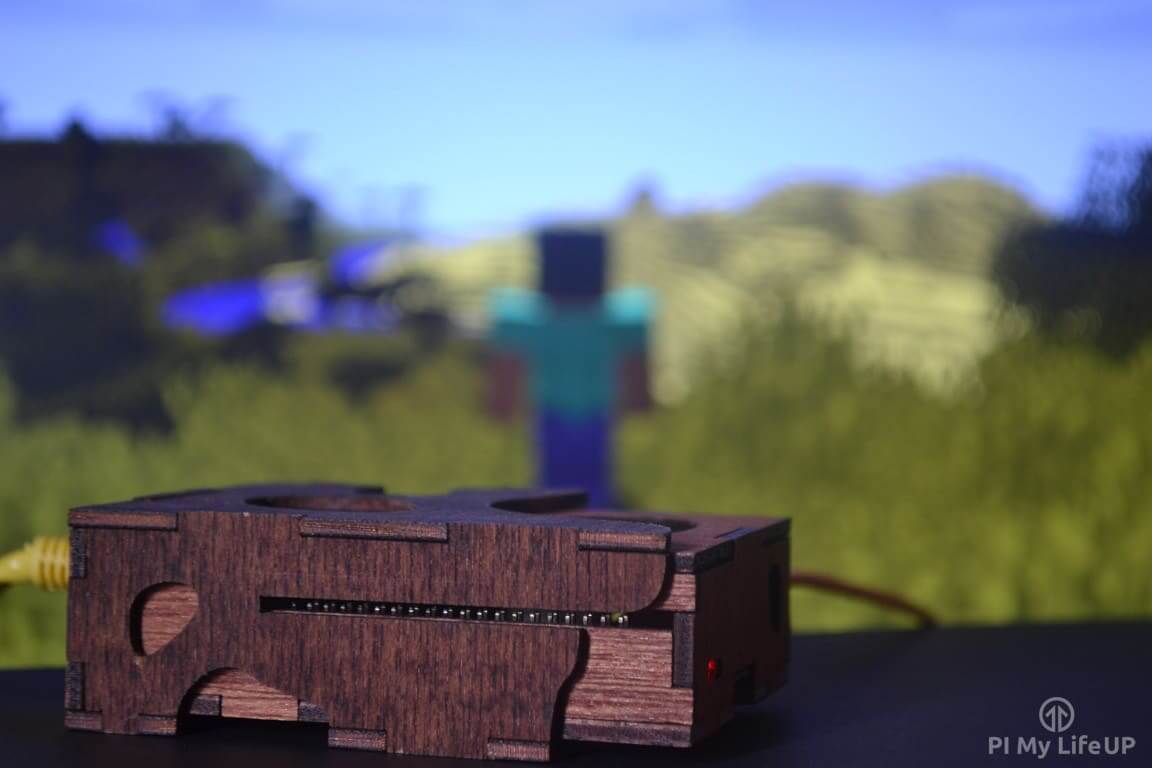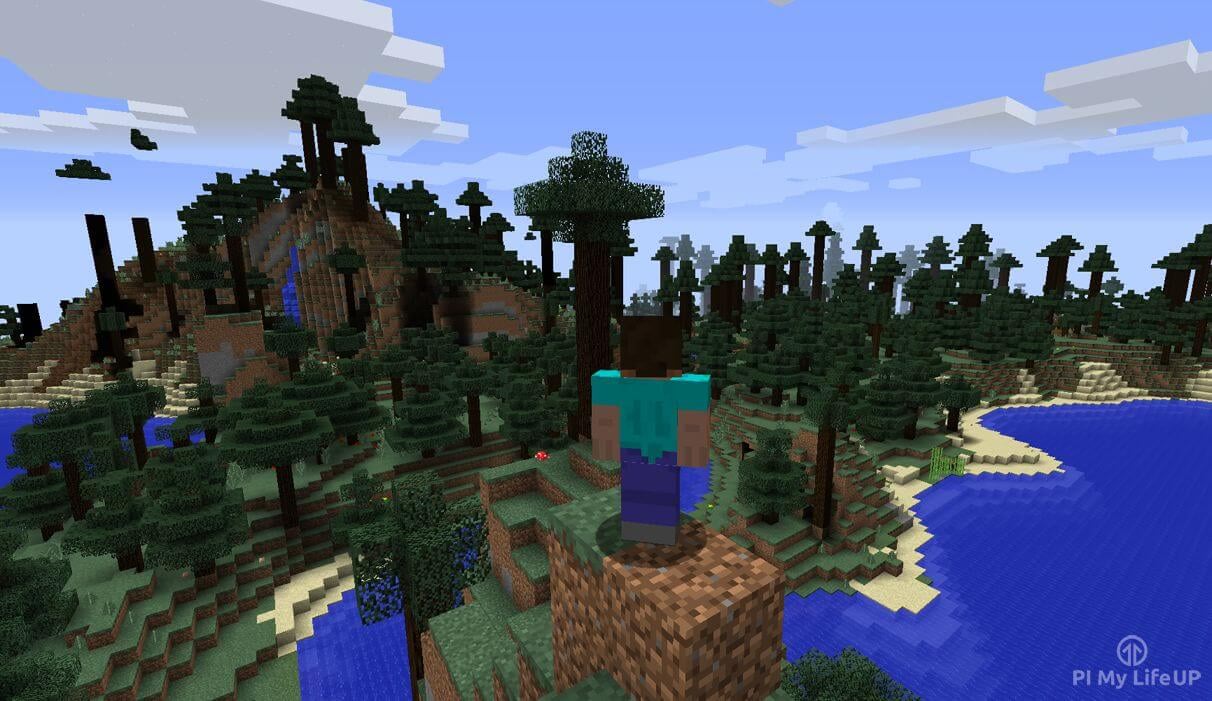A Raspberry Pi Minecraft server is a cost-effective way to have your very own private server with your friends or just for stuffing around on.

I have had mine running for quite some time now and haven’t come across too many problems. It is very important to know that this server will not be able to hold many people.
From my experience, anything over five people and the server will start to get a bit wonky. I found the optimal amount of people is only two to three, but this can be improved upon by tweaking the server.
We are also going to be using the spigot version of Minecraft as the default install didn’t work for me. I found that it will crash a lot, be laggy, and is very unstable. The official Java version may improve over time.
If you are looking for the Bedrock server, be sure to check out our Minecraft Bedrock server tutorial. It will take you through all the steps to setting it up correctly.
In this project, we will utilize Java, which should already be installed on Raspberry Pi OS. We will make a few changes to optimize the server for the Raspberry Pi 2, 3, 4, or 5. We will also set it up so you can access it on the web, and have it reboot if the Pi goes offline for any reason.
Equipment
Please find the equipment that I used for making this Raspberry Pi Minecraft server below.
Recommended
- Raspberry Pi Amazon
- Micro SD Card Amazon
- Ethernet Cable Amazon or Wi-Fi Amazon (I recommend using an ethernet for the best network performance)
- Power Supply Amazon
- USB Keyboard Amazon
- USB Mouse Amazon
Optional
Video Tutorial
If you want to see how to set up the server, then check out my video below. Otherwise, I have a detailed text explanation immediately below the video.
If you like the video, please make sure you subscribe or follow us on social media, so you are kept up to date.
Setting up the Raspberry Pi Minecraft Server
Firstly, we must install an operating system onto the Raspberry Pi. If you haven’t already done this, check out our awesome guide on installing Raspberry Pi OS. It will take you through all the steps that you will need to do.
In this tutorial, we will work entirely in the terminal. It is probably best we boot straight into the terminal so we can save on resources by not loading the GUI.
1. First, update operating system packages to the latest version by entering the following commands.
sudo apt update
sudo apt upgradeCopy2. Now, we will need to make a couple of changes in the config tool. Let’s bring the tool up by entering the following line.
sudo raspi-configCopyIf you need more information regarding the raspi-config tool, please check out our guide.
3. Also, it is unlikely you want to boot into the desktop, so ensure the boot option is set to the CLI (Command Line Interface). This change will help give the server as much processing power as possible.
To change the boot option, select 1 System Options, and select Boot / Auto Login.
Select Console or Console Autologin.
4. Finally, enable SSH so we can access the Pi remotely if required, unless you already have it enabled.
To enable SSH, go to Interface Options. Next, Select I1 SSH. Lastly, answer <YES> to enable the SSH server.
5. Now go to <Finish> on the main screen and answer <YES> to the reboot question.
6. We will now want the IP address of our Pi for when we try to connect to our server. To get the Raspberry Pi IP address, enter the hostname command.
sudo hostname -ICopyTo ensure the IP doesn’t change, you should set up setup a static IP address on the Raspberry Pi and your router.
7. Next, we need to make sure that Git and jq is installed. Otherwise, we will not be able to build the server.
Enter the following command to install the Git software as well as jq. jq allows us to easily interpret JSON data within the terminal.
sudo apt install git jqCopy8. By default, Java (17) should already be available on Raspberry Pi OS (Bookworm). However, if you wish to use the latest version of the Minecraft server, you will need to use a newer version than what is available.
To install a version of Java compatible with Minecraft 1.20.6 + (Java 21 or 22), please follow our installing Java guide.
9. Now, we will need the Minecraft server file, which we will create using a builder tool that Spigot supplies.
To get the tools, enter the following commands.
mkdir ~/minecraft
cd ~/minecraft
wget https://hub.spigotmc.org/jenkins/job/BuildTools/lastSuccessfulBuild/artifact/target/BuildTools.jarCopy10. Now we will want to run the build tools file, so it creates our Spigot server. It will take about 15 minutes to finish.
Change --rev latest at the end of the command to get a different version. Don’t forget to change latest in the command to the version number you wish to download. For example, --rev 1.20.6 will download version 1.20.6.
java -Xmx1024M -jar BuildTools.jar --final-name server.jar --rev latestCopyImportant: If you have a Raspberry Pi B+, B, or any variation before the Raspberry Pi 2, the build tools will likely fail. You will need to generate the spigot.jar on a more powerful computer instead.
11. To ensure the Spigot server successfully downloaded and saved, simply type ls. You should see spigot-1.20.6.jar. The filename may be different depending on the version you downloaded.
lsCopyMake sure you remain in the ~/minecraft folder as we want all the server files to be created in here. If you start the server in a different folder, it will create the files there.
12. Now we are ready to launch the server. To do this, enter the following command. You may need to change the version number depending on what version you’re using e.g. spigot-1.20.6.jar.
Raspberry Pi 1
java -Xms256M -Xmx496M -jar ~/minecraft/server.jar noguiCopyRaspberry Pi 2, 3, 4, or 5
java -Xms512M -Xmx1008M -jar ~/minecraft/server.jar noguiCopyWith the 2GB and 4GB variants of the Raspberry Pi 4 or 5, you can increase the Xmx value even higher.
The server will stop straight away as we will need to agree to the Eula. You can do this by opening the Eula by typing the following command.
nano eula.txtCopy13. In here, change “false” to “TRUE“. Once done, save and exit by pressing CTRL + X, then Y.
14. Now relaunch the server. It will take a while to create a map, so give it about three to five minutes. If you ever reboot again, it will only take thirty seconds to load if the map has already been created.
15. The server should be running and accessible over the local network.
16. You might want to mod your user now so that you can use all the server commands when you log in. If we have it auto-boot on startup, accessing the server backend is slightly more difficult.
To mod your user, simply run the following command when the server has launched (Replacing username with your username).
op username17. The Minecraft server on the Raspberry Pi will now be up and running fine, but you may want to do some optimizations to the server to make it run even better.

Connecting to the Minecraft Server
If you are on a local network, it should be pretty easy to connect to the Minecraft server running on the Raspberry Pi. To test it out, follow the steps below.
1. Load the Minecraft Java client on a computer within the same local network as the Pi. Ensure the version of the client matches the version of the server.
2. Go to multiplayer, and your server might appear in the local list. If it doesn’t, simply go to direct connect and enter the IP address we got earlier on the Pi using the hostname command.
hostname -ICopy3. If you want to allow access to the Minecraft server via the internet, you will need to set up port forwarding.
Assuming you want to learn how to do this, head over to my guide on setting up Raspberry Pi port forwarding. You will need to port forward the port 25565 (unless you change it in the server properties) to the IP of your Pi.
Configuring the Server
Here are a few tips for configuring the server and getting it up and running.
Optimizing the Minecraft Server
To get the most out of our Minecraft server on the Raspberry Pi, you can install a plugin to help optimize the performance.
There are many plugins that can help with performance or extend the server’s functionality. Simply use the wget command to download them to the Pi. Below is an example.
cd ~/minecraft/plugins
wget -O example.jar <example_plugin_url>CopyEditing the Minecraft Properties
You will probably want to know how to edit the server properties. This ability to edit is very important for optimizing the server and customizing it to how you want the server to be.
If you want more information for each of the server settings, you can find a good page on all the server properties here.
To enter the server properties, enter the following line.
sudo nano ~/minecraft/server.propertiesCopyNow, we will want to change a few settings to help optimize the performance of the server.
You can change these and other settings to whatever you like however you want, but keep in mind the Pi can’t handle too much processing.
view-distance=04
max-player=5CopyBoot on Startup
To have the server start on boot, we will need to do a few extra steps.
1. We will need to create a service for the Minecraft server so let’s start writing the service file by entering the command below.
sudo nano /lib/systemd/system/minecraftserver.serviceCopy2. In this file you will need to enter the following text.
This file defines the service, so the service manager knows how and what to run. Don’t forget to update the spigot version number whenever you upgrade.
Update “<USER>” with the username you plan on using to run the server. You can see the username of your user by entering the whoami command into the terminal.
[Unit]
Description=Minecraft Spigot Server
[Service]
User=<USER>
Group=<USER>
Restart=on-abort
WorkingDirectory=/home/<USER>/minecraft/
ExecStart=/usr/bin/java -Xms512M -Xmx1008M -jar /home/<USER>/minecraft/server.jar nogui
[Install]
WantedBy=multi-user.targetCopyOnce done, save the file by pressing CTRL + X then Y followed by ENTER.
3. Now, we will need to enable the service. You can enable the service by running the command below.
sudo systemctl enable minecraftserver.serviceCopy4. You should now be able to start the Minecraft server by simply using the following command.
sudo systemctl start minecraftserver.service5. Using a similar command, you can check on the status of the service. Checking the status is great for debugging.
sudo systemctl status minecraftserver.serviceCopy5. You can stop the server by using the following command.
sudo systemctl stop minecraftserver.serviceCopyYour server should now start on boot. You can test it by restarting the Raspberry Pi. It will take a few minutes to startup.
sudo rebootCopyIf you want to get access to the server on the command line, then you will need to shut down the server and load it using the normal command.
Updating your Minecraft Server on the Raspberry Pi
In this section, we will be showing you how to update to the latest version of the Minecraft server on your Raspberry Pi.
1. Before we can begin to update the Minecraft server, we will need to change to the directory where the server is stored.
If you have followed our tutorial, this means you should be able to change to the correct place by running the command below.
cd ~/minecraft/Copy2. The first thing we will want to do now that we are in the right place is ensure we have the latest version of the Spigot build tools.
We can use the wget command to download the latest release by using the following in the terminal.
wget https://hub.spigotmc.org/jenkins/job/BuildTools/lastSuccessfulBuild/artifact/target/BuildTools.jarCopy3. With the build tools updated, we can now grab the version number for the latest version of the Minecraft server by using the following command.
If you have a particular version of the Minecraft server, you want to use on your Raspberry Pi replace the command with that here. Otherwise, we can use a bit of curl and jq magic to get the version number we are after.
MINECRAFT_VERSION=$(curl -sS https://launchermeta.mojang.com/mc/game/version_manifest.json | jq -r '{latest: .latest.release} | .[]')Copy4. Once you have got your version number saved to the environment variable we can proceed.
Before we can update the Minecraft server on our Raspberry Pi, we will need to stop the current one from running. You can stop the running server by running the command below.
sudo systemctl stop minecraftserverCopy5. Now use the Spigot build tools to download and update you Minecraft server to the latest version.
Please note that this process can take a couple of minutes to complete.
java -Xmx1024M -jar BuildTools.jar --final-name server.jar --rev $MINECRAFT_VERSIONCopy6. Once the update process completes, you can start the server up by using the following command.
sudo systemctl start minecraftserverCopyConclusion
I hope this tutorial has helped you in setting up a stable version of a Raspberry Pi Minecraft server. If you like this tutorial, then be sure to check out our many other Raspberry Pi Projects.
Also, feel free to drop us a comment below if you have better optimization settings, plugins, or ideas. If you’re having trouble, let us know below.










Hi it was a nice tutorial thanks for it but how to delete a plugins ?
Same issue as Corey -> Feb 9 | Frozen command line on reboot
I'm having this exact same issue and no idea how to solve it. The server however is working.
Hi Gus,
going to try creating the minecraft server tonight….fingers crossed! hahaha.
But I have a small other question about the Pi. When I was running OpenElec with Kodi and I pulled the power cable out OpenElec had to be reinstalled from the ground up.
Is that allso the case with this minecraft server?
A Pi doesn’t have a power button. So how do I shut-down the server propperly so I don’t lose data and don’t have to reinstall it over again?
With kind regards,
Mike
The Netherlands
Write “stop” in the commandline.
If you login to the pi via ssh and enter this it will shut down
sudo shutdown -h now
This worked great for me, thank you. We have had quite a bit of use of the last two weeks 🙂
With the update today to to 1.9 minecraft how to I easily (hopefully) update the server, without losing the config, whitelist and world etc.
Kind Regards,
Steve
Hi Steve,
To update you will need to redownload the buildtools and have
--rev 1.9at the end of the command when you go to run them eg.sudo /opt/jdk1.8.0_60/bin/java -jar BuildTools.jar --rev 1.9When you run them you should have a new server to run called spigot-1.9.jar.
Something like the following should back up your entire minecraft folder just in case anything goes wrong.
sudo mkdir /home/minecraft_backupsudo cp -R /home/minecraft/* /home/minecraft_backup/
Double check to make sure it all copied over correctly by using something like:
ls /home/minecraft_backupMorning Gus,
I would have missed the –rev switch. Took a while to update, but worked without a hitch and my son and I are enjoying playing Minecraft 1.9 on our Pi 2 server.
We would like to thank you, both for the initial Tutorial and your prompt response regarding the update process. Your readers may like to look at a plugin we found to help keep the monster spawns to a reasonable level, it’s called Clearlagg.
Hope you all have a lot of fun.
Cheers,
How do I update the minecraft server if Spigot updates to 1.9?
Otherwise it works perfect! 😀
Hi Anglaborg,
Spigot updated to 1.9 today to update you will need to either download the buildtools again and use the tag
--rev 1.9when you run it or I have a prebuilt version further up on this page you can download.I would recomened backing up banned-ips.txt, banned-players.txt, ops.txt, server.properties and the world folder beofer you go to update just in case.
Something like
sudo mkdir /home/minecraft_backup
sudo cp -R /home/minecraft/* /home/minecraft_backup/
This should back up the entire minecraft folder to minecraft_backup.
Thank you! Tried it and it worked perfectly after I updated/redownloaded the newest BuildTools.jar!
One question:
I start the server with “sudo java………”
instead of “sudo /opt/jdk1.8.0_60/bin/java……..”
So is there any difference or why should I do the “sudo /opt/jdk1.8.0_60/bin/java…”?
There is no difference,
/opt/jdk1.8.0_60/binwas required as Raspbian Wheezy didn’t include Java by default. Raspbian Jessie however includes Java by default so we can just use “java” now.Hi Guys,
Great tutorial! My sons are playing Minecraft for about a week now. They around 6 and 7 years so.. 🙂
And I would like to setup a minecraft server so they can play in that world with there friends.
I have a Pi 2 model B that’s running OpenElec but I want to use the Pi now for the server.
As I need to start from scratch I need Raspbian.
But there is Raspbian and Raspbian Lite. Can I use both for this?
Hope you can help me out here.
With kind regards,
Mike
The Netherlands
Hey Mike, Either of those should work just fine. I would personally probably go the Lite version for a server since there will be less overhead.
I haven’t tried doing doing this on the lite OS so you might run into problems.
If you do just let me know!
Hi Gus,
Thanks for your reply.
I’ll have a go at it…the Lite version I mean. I’m not a programmer so I hope all goes well! 🙂 hahahaha.
If I run into problems your the first one I notify. 😉
Kind regards,
Mike
Hi,
So when I made the startup start.sh file, Im not sure but I dont think I included the “nogui” part and now when the device boots, it automatically loads the server however doesnt have the “>” sign that shows I can use commands and instead it is just blank. I can type anything in and when I press enter, nothing will happen, it just goes onto the next blank line, is there anyway I can access the rc.local file or start.sh so I can modify it?
Even anyway to just kill the server so I can go back to the main console?
Any help is appreciated, thank you
Take a snapshot of the memory usage stats at the time the server crashes. Also check for disk usage. If you want to use a monitor tool for memory and disk usage I’d recommend the Nagios monitoring tool.
omg it’s working.
I didn’t want to buy a server, so I wanted to make one on my pi and succes.
without your tutorial I wouldn’t succeed!
I was able to get this up and running for a few days and then without making any changes it crashes every time time. I have the latest.log file posted in case anyone can maybe identify what is happening.
Hi Gus, I have a situation with the final sudo reboot. Once I set the file to automatically start upon a reboot, it loads but never lets me do anything. It constantly loads and never allows commands to be entered. But once I deleted the addon in rc.local it allowed me login up reboot. Is there a way around this or a way to not start the server automatically but still be able to start it?
This meant to be a reply of the one above ^^
Hiya Gus, thanks for the awesome tutorial. Just one problem from me that I have no clue what to do about. When I run sudo reboot to test the server starting automatically, it does all its loading and what not. But then I get to the INFO message “Done (6.234s, < this always changes)! For help, type "help" or "?" After this nothing happens and I can not enter any commands. Did I possibly upload a file wrong? Is my PI messed up? I have no clue here, anything from anyone would be greatly appreciated.
whenever I run the “sudo -Xms512M -Xmx1008M -jar /home/minecraft/spigot-1.8.8.jar nogui” command, it fails, saying sudo: invalid option – – ‘X’ please tell me how I can fix this. I would really like to play with my friends, and none of the other tutorials out there help me.
Hi Griffin,
Make sure your command contains a call to java otherwise it won’t understand the Xms commands. Also sometimes if you copy and paste the “-” won’t be correct but looks the same.
The following should work if you’re running a Raspberry Pi 2 with Raspbian Jessie.
sudo java -Xms512M -Xmx1008M -jar /home/minecraft/spigot-1.8.8.jar noguiLet me know if that helps!
Yes. That helped so much! Thank You! I never thought it could be that simple…
I followed the tutorial above and have had the server up and running for a week or so. I can’t seem to get any plugins working though. I installed the NoSpawnChunks plugin per the tutorial and assumed that it was working. But when I tried to install others, such as Essentials it looks like none of them are. I looked at the compatibility list for 1.8.8 and only have plugins that are marked as working, but when I do >plugins, I always get Plugins (0):
Even after rebooting the server and confirming they are in the correct folder (/home/minecraft/plugins/).
Any suggestions?
How do you make someone op?
I found this really good!
http://minecraft.gamepedia.com/Commands
/op name (or fist three of four letters of the name + tab)
/deop name removes it again.
After set the autostart, how do I get in the console/window to see the (screen) log and where I can give the op commands?
how do you exit eula.txt?
I had the same problem. Do:
Ctrl X
Y
Enter (return)
Control X exits the text file, the Y tells the computer to save the change, and the enter saves it as eula.txt, overriding the eula.txt with “false”
Hope this helps.
How do i get the minecraft console when i have the server start on boot up
You go to
https://[your.server.ip.here]:8443and log in. From there go to the drop down menu and select your server. Now in the navigation bar on the left several things will appear one of which is your server log. Go to the server log and that’s where your console will be slumbering 🙂Thanks for posting this — it has been very helpful.
One suggestion I would make though, is to update the instructions so that ‘sudo’ is only used when truly needed.
We’re using the latest Raspbian that includes Java. We created a user named ‘minecraft’ (with the ‘adduser’ command) and have run many of the commands from that account without sudo (starting with the wget of BuildTools.jar) and have the server up and running.
We haven’t done the optimization or boot-on-startup yet, but will be doing that today and will let you know if we have any issues.
Thanks again, for creating this post!
When I run step 14 (The step to download the Spigot.jar) It takes about 30 min, like Gus said it would, but then gave me an error and when I compare the files I have to what Gus has, it shows me that I have all the same files except for the spigot1.8.8.jar and the craftbukkit1.8.8.jar
I am scared to do the command again for fear of downloading something twice and messing future things up. Any thoughts?
This is a great tutorial, and other than this slight bump in the road it has been perfect.
*replying to own comment*
Also, I have a Pi 2 B with Raspbian Jessie.
Hello! Thanks for a superb tutorial!
I’ve now setup up the server, and it’s running.
My question is, how do I get to the minecraft-server now, when it starts automatically?
Best regards
//Peter